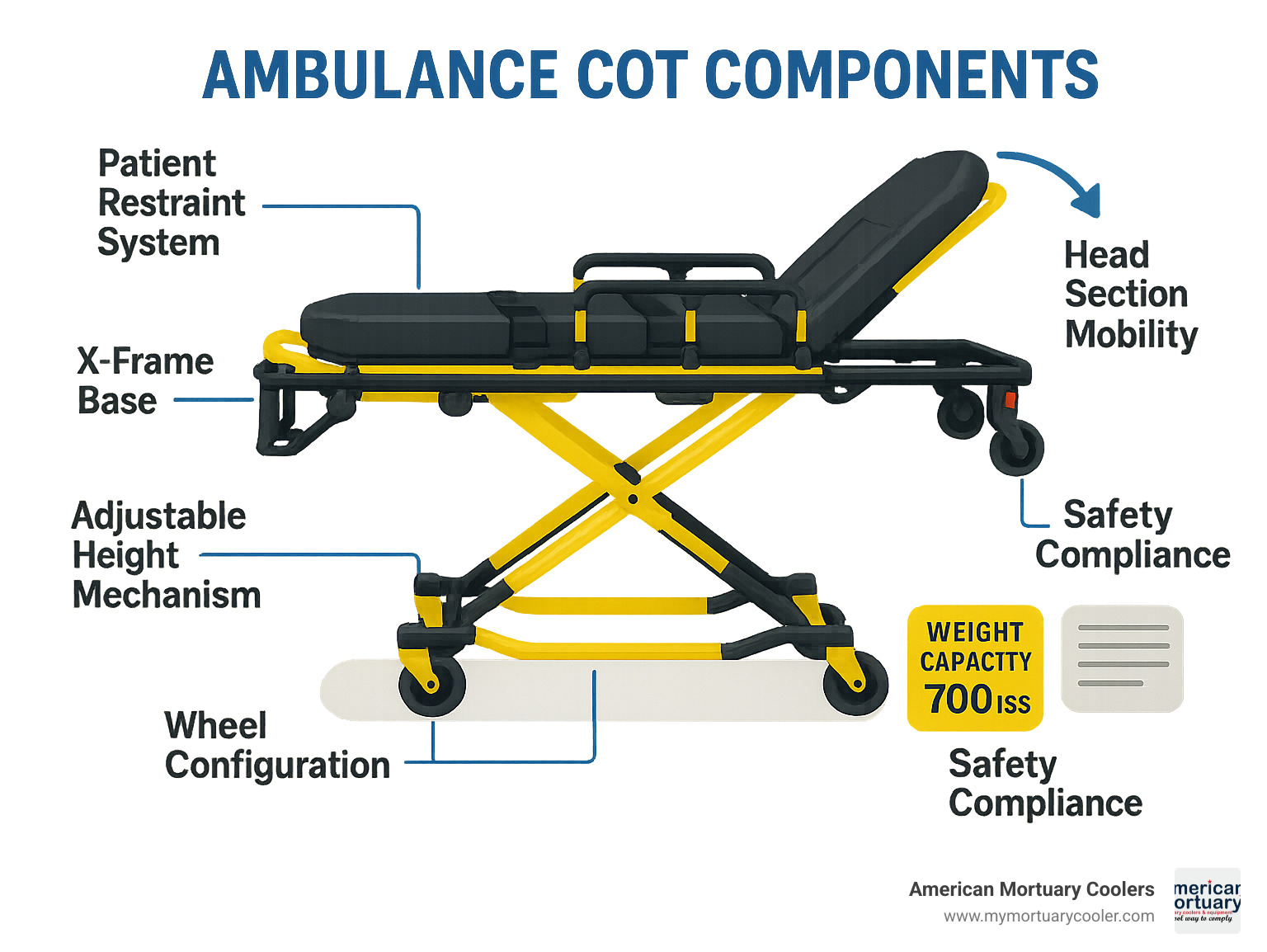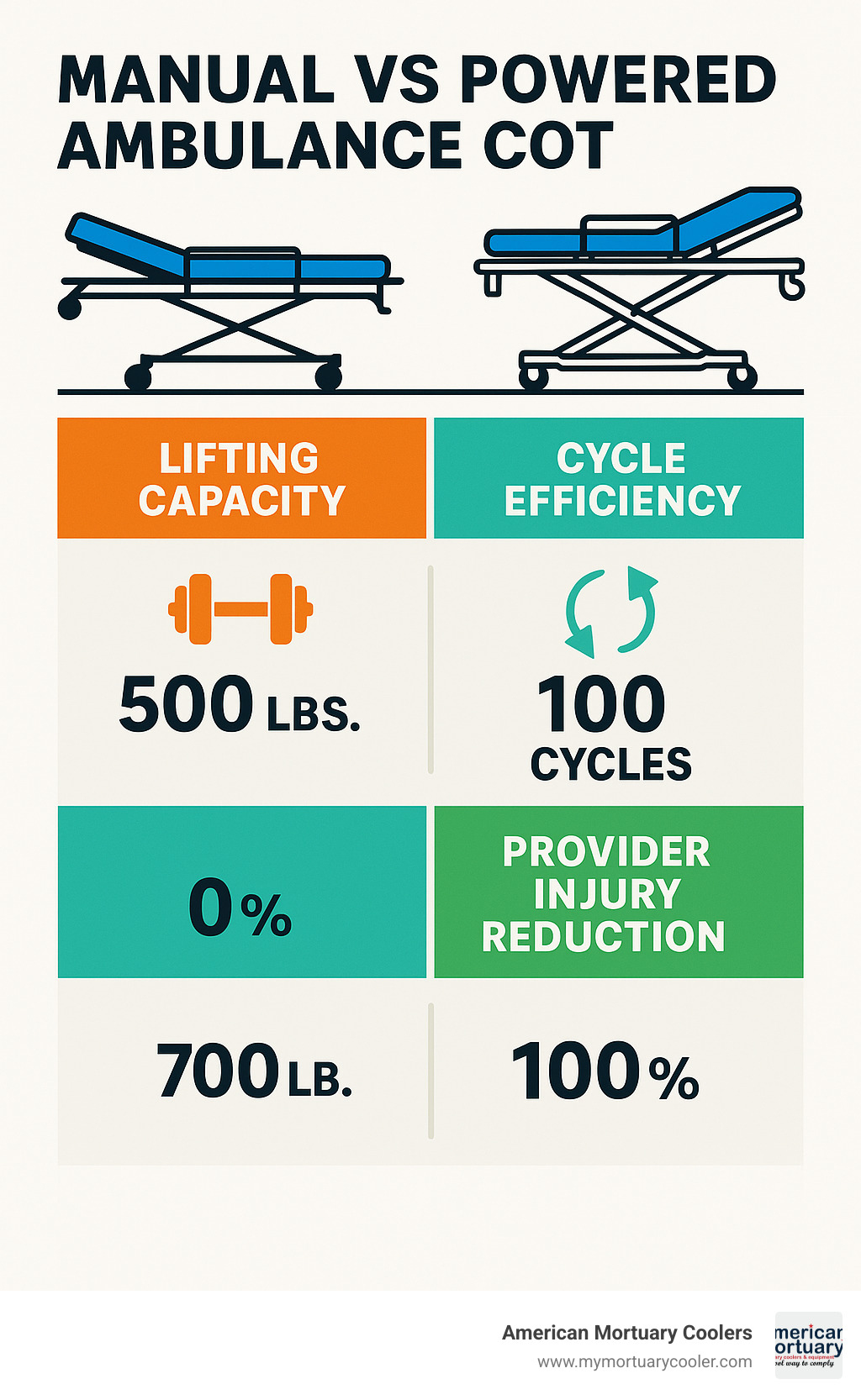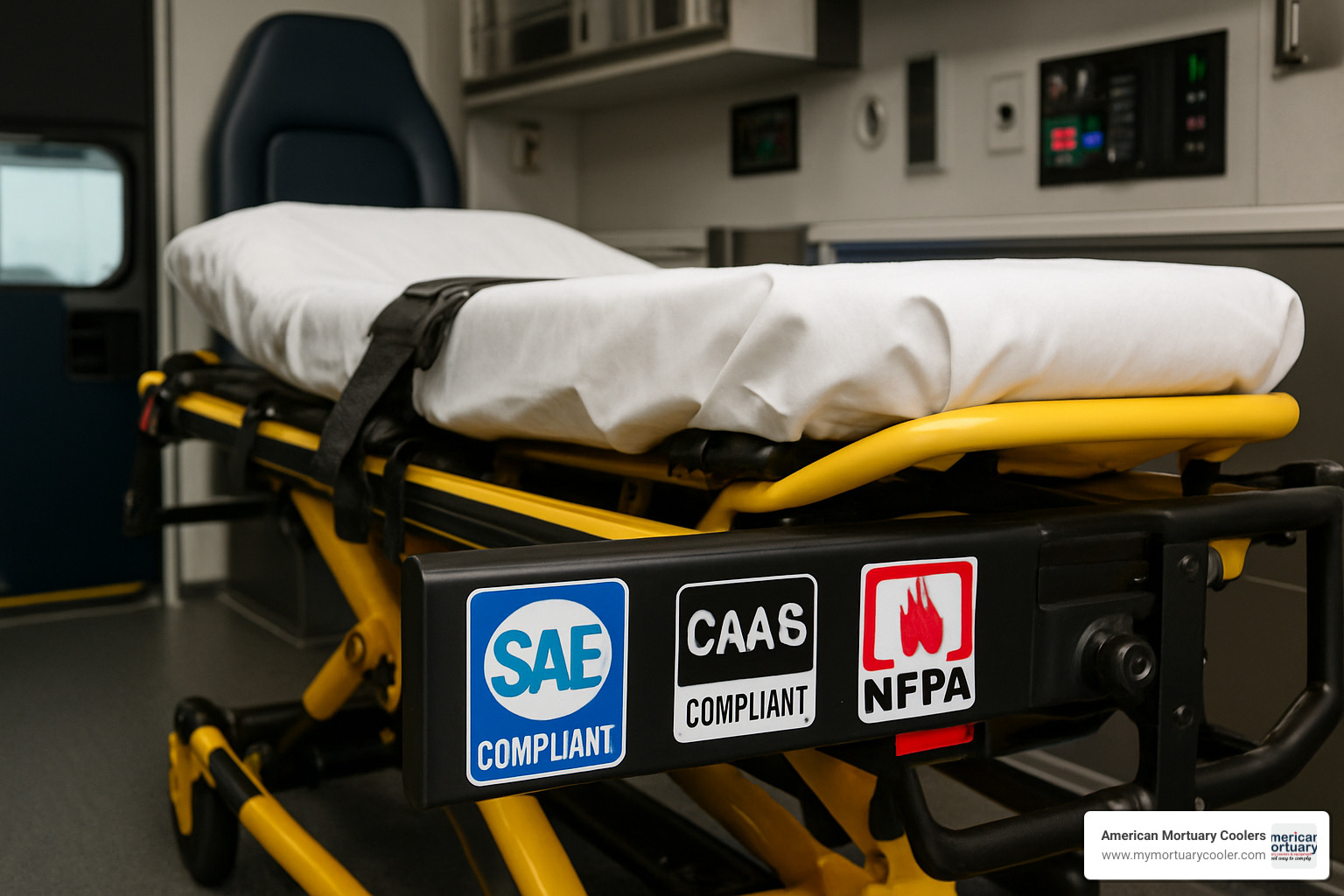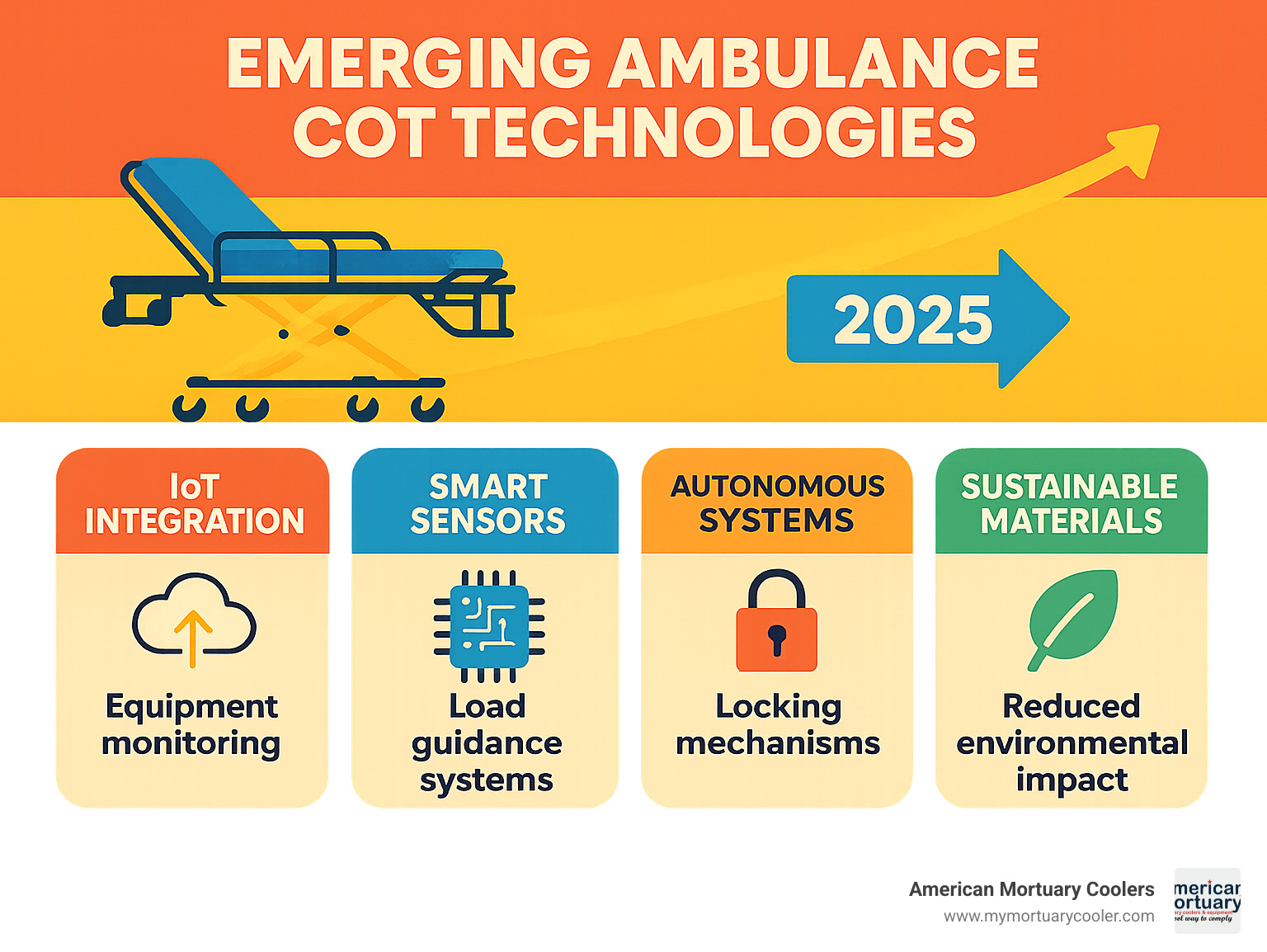Why Choosing the Right Ambulance Cot Matters for Your EMS Operations
An ambulance cot is a specialized wheeled stretcher designed to safely transport patients from emergency scenes to medical facilities while providing secure restraint and height adjustability for easy loading into ambulances.
Key ambulance cot specifications to know:
- Weight capacity: 350-700 lbs depending on model type
- Power systems: Manual X-frame, powered hydraulic, or hybrid designs
- Load heights: Typically 3-8 adjustable positions (11-44 inches)
- Frame types: X-frame for stability, H-frame for maneuverability
- Safety standards: Must meet SAE J3027, CAAS-GVS, and NFPA 1917 requirements
Modern ambulance cots have evolved far beyond simple pole stretchers. Today's powered cots like the FERNO Power X1 offer 700 lb unassisted lift capacity and can complete 113 cycles per charge, while manual models like the Stryker Performance-PRO XT provide 360-degree head mobility and three-position load heights.
Getting the wrong ambulance cot can lead to provider injuries, failed inspections, and poor patient outcomes. Understanding the key differences between manual versus powered systems, weight capacities, and safety features makes selection straightforward.
As American Mortuary Coolers with experience in medical transport equipment, we've helped numerous EMS organizations find durable, compliant solutions that fit their specific operational needs. This comprehensive guide will walk you through everything from basic cot anatomy to advanced powered features, helping you make an informed decision for your fleet.

Ambulance Cot 101: Definition & Primary Purpose
What is an ambulance cot?
Think of an ambulance cot as the workhorse of emergency medical services - it's far more than just a stretcher on wheels. This specialized piece of equipment serves as your primary patient transport platform, designed to handle everything from routine transfers to critical emergency calls.
What sets ambulance cots apart from regular hospital gurneys or other stretchers? The primary purpose revolves around three key jobs: keeping patients safe during bumpy rides to the hospital, protecting your crew's backs during countless lifts, and fitting perfectly with your ambulance's fastening systems.
The magic happens with the load height feature. Modern cots adjust anywhere from about 11 inches at their lowest point up to 44 inches at transport height. This means you can match your ambulance floor perfectly, whether you're dealing with a high-top van or a lower truck-style unit.
Every quality ambulance cot includes a solid restraint system with color-coded straps, smooth-rolling wheels that actually turn when you need them to, and either manual or powered height controls depending on your budget and needs.
Why every ambulance needs a modern ambulance cot
Here's the reality: outdated cots aren't just inconvenient - they're genuinely dangerous for both your crew and your patients. EMS providers already face some of the highest workplace injury rates around, and a lot of those injuries trace back to wrestling with old, clunky equipment.
Crew ergonomics improve dramatically with modern designs. Features like three-position adjustable heights and ergonomic handles mean your team can work smarter, not harder.
Patient outcomes get better too. Modern stability technology provides significantly more stability at transport height compared to older designs. Translation? Much lower risk of patient falls during transfers. Add in shock frames and pneumatic backrests, and you're talking about significantly more comfortable rides for people who are already having the worst day of their lives.
When it comes to rapid deployment, modern powered cots really shine. They can handle multiple lift cycles without wearing out your crew, which becomes crucial during busy shifts or mass casualty events.
From Pole Stretchers to Power-Loaders: The Evolution of Ambulance Cots
The evolution of ambulance cots reflects changing demographics, vehicle designs, and our understanding of ergonomics in emergency medicine. Early ambulance services used simple pole stretchers that required significant manual effort and provided minimal patient comfort.
Key milestones in ambulance cot design
The journey from pole stretchers to modern powered systems spans over a century of innovation. In 1898, Bomgardner Manufacturing was founded, introducing the four-swivel-wheel stretcher around 1910 - a significant improvement over basic pole designs.
The introduction of aluminum construction in 1926 marked the first major weight reduction breakthrough. The first aluminum ambulance cot dramatically reduced the physical burden on providers while maintaining structural integrity.
The 1952 introduction of the elevating Two Level cot revolutionized height adjustment. This design allowed providers to match cot height to various loading surfaces, reducing the lifting strain that caused widespread provider injuries.
X-frame versus H-frame designs emerged as competing philosophies in the 1960s and 1970s. X-frame construction provided superior stability during transport, while H-frame designs offered better maneuverability in tight spaces.
The battery-powered revolution began in 2005 with the introduction of powered systems, offering up to 700 lb unassisted lifting capacity. This breakthrough addressed the growing challenge of bariatric patients while protecting providers from lifting injuries.
How rising patient weights shaped cot innovation
The increasing average patient weight in America directly drove ambulance cot innovation over the past several decades. As patient demographics shifted toward higher weights, traditional manual cots became inadequate for safe patient handling.
Bariatric transport capabilities became essential rather than optional. Modern cots now routinely support 700 lb capacity, with some specialized bariatric models handling even higher weights.
Provider injury rates from manual lifting created an urgent need for powered assistance. Studies showed that EMS providers experienced back injuries at rates significantly higher than other healthcare workers, largely due to awkward lifting positions and heavy patients.
The shift from station wagon ambulances to modular box designs also shaped cot evolution. Modern ambulances have higher floor heights, making manual lifting even more challenging. Adjustable load height systems became essential for matching ambulance floor levels.

Types, Features & Accessories to Compare Before You Buy
Understanding the different types of ambulance cots and their features is crucial for making an informed purchasing decision. Each design philosophy addresses specific operational needs, from basic manual transport to advanced powered systems with integrated loading capabilities.
Choosing the right ambulance cot for your fleet
Selecting the right ambulance cot depends on your specific mission profile, operational environment, and budget constraints. High-volume urban services with frequent bariatric transports benefit most from powered systems, while rural services with limited call volumes might find manual cots more cost-effective.
Mission profile analysis should consider your typical patient demographics and transport scenarios. Services handling primarily elderly patients from nursing facilities need different capabilities than trauma-focused operations.
Terrain considerations affect wheel configuration and stability requirements. Urban services operating on smooth surfaces can prioritize maneuverability, while rural services need robust construction for uneven terrain.
Crew size and demographics influence power system selection. Smaller crews or services with diverse physical capabilities benefit more from powered assistance.
Must-have safety & comfort features
Modern ambulance cots incorporate numerous safety and comfort features that directly impact patient outcomes and crew safety. Understanding these features helps identify which models best meet your operational requirements.
Adjustable load height stands as the most critical safety feature for crew protection. Three-position adjustment allows crews to match ambulance floor height, reducing lifting strain and injury risk.
Advanced stability technology represents a significant advancement in patient safety. Modern systems provide significantly more stability at transport height compared to older designs, virtually eliminating tip-over incidents during patient transfers.
Color-coded restraint systems prevent securing errors during high-stress situations. Quick-release mechanisms allow rapid patient access during medical emergencies while maintaining security during transport.
Shock frame construction protects patients from road vibration and impacts during transport. This feature proves especially valuable for trauma patients or those with spinal injuries where movement must be minimized.
Retractable head sections enable 360-degree mobility in any height position, crucial for maneuvering in tight spaces like nursing home rooms or narrow hallways.
Accessories & fastening systems that matter
The right accessories and fastening systems can significantly improve ambulance cot functionality and safety. These add-ons often determine whether a cot integrates seamlessly with your existing ambulance fleet and operational procedures.
Essential accessories include:
- IV poles for medication administration during transport
- Oxygen holder brackets for respiratory support equipment
- Side-lift handles for improved ergonomics during manual positioning
- Equipment platforms for organizing medical supplies
- Mattress upgrades for improved patient comfort
- Restraint system upgrades for specialized patient populations
Stat-trac mounting systems ensure secure cot-to-ambulance connection during transport. These systems must be compatible with your ambulance manufacturer's specifications and meet current safety standards.
Power-LOAD systems represent the latest advancement in automated loading technology. These systems eliminate manual lifting entirely by using powered mechanisms to load and unload cots from ambulances.
More info about ambulance stretcher benefits
Standards, Ergonomics & Total Cost of Ownership

When you're investing in an ambulance cot, you're not just buying equipment – you're making a decision that affects crew safety, regulatory compliance, and your budget for years to come.
Meeting the latest safety regulations
Safety standards for ambulance cots aren't just bureaucratic paperwork – they're the difference between equipment that protects lives and equipment that puts people at risk. The main standards you need to know are SAE J3027 for patient-compartment design, CAAS-GVS for ground-vehicle standards, and NFPA 1917 for ambulance specifications. For a full technical breakdown, see the official SAE J3027 crash-cot standard.
SAE J3027 puts ambulance cots through serious crash testing to make sure they'll protect patients if the worst happens. These tests simulate real-world accidents and measure how well restraint systems hold up under extreme forces.
The CAAS-GVS standard ensures your cot will actually work with your ambulance. This might sound obvious, but compatibility issues between cots and ambulances cause real problems during inspections and daily operations.
NFPA 1917 covers fire safety and electrical requirements, which becomes especially important with powered cots. Battery systems need proper ventilation and fire-resistant materials.
Protecting your crews: ergonomic best practices
EMS providers get hurt on the job more than most healthcare workers, and a lot of those injuries happen during patient lifting and cot operations. Good ergonomic design isn't a luxury – it's essential for keeping your crews healthy and working.
Three-position load height adjustment makes the biggest difference in preventing back injuries. Crews can set the cot low for getting patients on, medium for transport, and high for loading into the ambulance.
The 360-degree head mobility feature found on advanced models lets crews work from the best position instead of wrestling around a fixed head section. When you're trying to provide care in a cramped nursing-home room, this flexibility prevents a lot of strain.
Even the best equipment won't prevent injuries if crews don't use proper techniques. Training should cover body mechanics, team lifting, and equipment-specific procedures.
Budgeting: purchase price vs lifecycle costs
The sticker price on an ambulance cot is just the beginning of what you'll spend over its lifetime. Smart budgeting looks at maintenance, service, battery replacement, and the hidden costs of crew injuries.
Manual cots cost less upfront but can end up being more expensive if they lead to worker-compensation claims or crew turnover. Powered systems require a bigger initial investment but often pay for themselves through reduced injuries and improved efficiency.
Service plans help you predict maintenance costs and keep equipment running reliably. It's much cheaper to replace parts on schedule than to deal with equipment failures during emergencies.
Battery life affects long-term costs more than many people realize. Plan on battery replacement every 3-5 years depending on how much you use the equipment.
Parts availability and service-network coverage can make or break your long-term costs. Manufacturers with good service networks and readily available parts keep your equipment running and your costs predictable.
Brand Showdown & Future Trends
Choosing the right ambulance cot means understanding what each major manufacturer brings to the table. The market has some clear leaders, each with their own strengths and specialties that might make them perfect for your specific needs.
Leading models compared on real-world metrics
When you're comparing ambulance cots in the real world, the numbers tell an interesting story. The FERNO Power X1 absolutely dominates in raw performance metrics. This powerhouse delivers 113 cycles per charge with a 250 lb patient - that's enough to handle even the busiest shifts without breaking a sweat. The ENDURACharge Power System packs 69% more power than its closest competitors, while the leg retraction happens 40% faster than other models.
What really sets the Power X1 apart is its TipRESIST technology, which provides 82% more stability at transport height. That's not just a number on paper - it's the difference between a secure patient transfer and a potentially dangerous situation. The 700 lb unassisted lift capacity means your crew can handle everything from routine transports to bariatric patients without strain.
The Stryker Performance-PRO XT takes a different approach, focusing on manual operation excellence. This ambulance cot also handles 700 lbs, but where it really shines is in maneuverability. The retractable head section gives you 360-degree mobility, which is a game-changer when you're navigating tight nursing home hallways or cramped apartment buildings.
Stryker's three-position adjustable load height promotes proper body mechanics - something your crew's backs will thank you for after years of service. The textured lift and grip surfaces might seem like a small detail, but they make a real difference during those challenging transfers in less-than-ideal conditions.
The Stryker Power-PRO 2 bridges the gap between manual and fully powered systems. It offers hydraulic height adjustment with manual backup systems, so you get the benefits of powered assistance without losing functionality if something goes wrong.
Budget-conscious services often look at the MOBI Pro X-Frame, which delivers solid performance at a more attractive price point. The 500 lb weight capacity handles most patient scenarios, while eight height adjustment levels provide good flexibility. The foldable head end is particularly useful for tight spaces, and the X-frame construction ensures stability during transport.
What's next for the ambulance cot?
The future of ambulance cots is getting pretty exciting, and it's not just about lifting heavier weights or lasting longer between charges. We're looking at a complete change of how these essential tools work.
Smart load guidance systems are already in development that will use sensors to detect patient weight automatically. Imagine your cot adjusting its settings without any guesswork, ensuring optimal safety and crew ergonomics every single time.
IoT sensors will soon provide real-time equipment monitoring that goes way beyond simple battery indicators. These systems will track usage patterns, predict maintenance needs, and even send alerts when something needs attention.
Autonomous locking mechanisms represent perhaps the most significant safety advancement coming down the pipeline. These systems will use advanced sensors to verify proper alignment and engagement before allowing transport to begin.
Telematics integration will give services unprecedented insight into their operations. You'll know which cots are being used most heavily, when maintenance is actually needed, and how to optimize deployment across your service area.
The materials science side is advancing too. Lighter composite materials may eventually replace traditional aluminum construction while maintaining the strength and durability that emergency services demand.
Advanced battery technology, including potential solid-state batteries, promises longer service life and improved safety compared to current lithium-ion systems. Faster charging times and extended operational capacity will reduce downtime and improve service readiness.

Frequently Asked Questions About Ambulance Cots
How much does an ambulance cot cost?
Ambulance cot pricing depends heavily on whether you choose manual or powered systems. Manual cots typically start around $2,000 for basic models and can reach $8,000 for feature-rich designs.
Powered systems represent a much larger investment, generally running $15,000 to $25,000 or more. Advanced models command premium pricing due to their sophisticated battery systems, 700 lb lift capacity, and advanced safety features. While the upfront cost seems steep, many services find that powered systems pay for themselves through reduced worker compensation claims and improved crew retention.
Don't forget to factor in the total cost of ownership when budgeting. Powered cots need battery replacements every 3-5 years and more frequent maintenance, but they may actually save money long-term by preventing costly provider injuries.
What weight capacity should I choose?
Weight capacity selection really comes down to knowing your patient population and planning for the unexpected. The 700 lb capacity found in top models handles virtually any patient transport scenario you'll encounter, including the bariatric cases that are becoming increasingly common across all service areas.
If you primarily serve elderly populations from nursing facilities, you might think a 350-500 lb capacity would suffice. However, patient weights continue increasing nationally, and you never know when you'll encounter a bariatric emergency. Having that extra capacity provides crucial operational flexibility.
Services in areas with higher obesity rates should definitely prioritize the 700 lb capacity range. There's nothing worse than arriving on scene only to find your equipment can't safely handle the patient.
How often should ambulance cots be serviced?
Service frequency depends on how hard you work your equipment and what type of system you're running. High-volume urban services should plan on quarterly professional inspections, while rural operations with lighter call volumes can often extend to twice-yearly service intervals.
Powered systems need more attention than manual cots, especially regarding battery maintenance and electrical system checks. Most batteries last 3-5 years with proper charging practices, but neglect them and you'll be replacing them much sooner.
Some newer powered models include cycle counters that track actual usage, taking the guesswork out of service scheduling. Instead of going by calendar dates, you can schedule maintenance based on how much work the cot has actually done.
Don't overlook daily operational checks by your crews. A quick inspection of restraint systems, wheel operation, and height adjustment can catch problems before they strand you during an emergency call.
Conclusion
Choosing the right ambulance cot can feel overwhelming with all the options available, but it doesn't have to be. The journey from basic pole stretchers to today's sophisticated powered systems shows just how much the industry has evolved to protect both patients and the crews who serve them.
Your ambulance cot decision comes down to a few key factors: matching weight capacity to your patient demographics (we recommend 700 lb capacity for maximum flexibility), selecting power systems that fit your call volume and crew needs, and ensuring compliance with SAE J3027, CAAS-GVS, and NFPA 1917 standards. Don't forget about ergonomic features that protect your crews' health and help them have longer, healthier careers.
The numbers tell the story. Modern cots deliver impressive performance and provide significantly better stability than older models. That's not just impressive engineering - it's real protection for your patients and crews.
Here's something many services overlook: staff training matters just as much as the equipment itself. Even the most advanced powered cot won't prevent injuries if your crews don't know how to use it properly. Make sure your training covers equipment-specific operations, basic ergonomic principles, and what to do when things go wrong.
Think about the future when making your choice. Smart technology integration and IoT sensors are coming to ambulance cots, just like they've revolutionized other medical equipment. The cot you buy today should be able to adapt to tomorrow's requirements while meeting today's evolving safety standards.
At American Mortuary Coolers, we've seen how the right medical transport equipment makes all the difference. Our work across Tennessee, Atlanta, Chicago, and throughout our service area has taught us that successful equipment selection starts with understanding your specific operational needs. Every service is different, and cookie-cutter solutions rarely work.
Whether your operation needs basic manual cots for lower-volume calls or advanced powered systems for busy urban services, the secret is matching equipment capabilities to your real-world requirements. Keep crew safety and patient outcomes at the center of your decision, and you'll make the right choice.
The investment in quality ambulance cot equipment pays dividends in reduced injuries, better patient care, and improved crew morale. Your team deserves equipment that works as hard as they do, and your patients deserve the safety that modern cot technology provides.


















